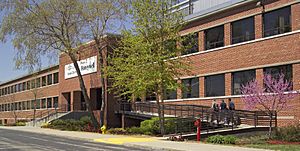Bannister Federal Complex facts for kids
Quick facts for kids Bannister Federal Complex |
|
|---|---|
| Kansas City, Missouri | |

Kansas City Plant
|
|
| Coordinates | 38°57′29″N 94°34′08″W / 38.958°N 94.569°W |
| Site information | |
| Controlled by | Department of Energy (NNSA) General Services Administration |
| Site history | |
| Built | 1942 |
| In use | 1942 – present |
| Garrison information | |
| Occupants | NNSA, operated by Honeywell GSA Regional Headquarters United States Marine Corps Department of Veterans Affairs Department of Commerce Department of Agriculture (USDA) |
The Bannister Federal Complex is a large group of buildings in Kansas City, Missouri. It's a special place used by the U.S. federal government. The complex covers about 310-acre (125.5 ha) and has 10 main buildings.
The General Services Administration (GSA) and the Department of Energy are the main groups working here. A big part of the complex is the Kansas City Plant. This plant makes important non-nuclear parts for the country's nuclear defense systems. The Bannister Federal Complex was added to the National Register of Historic Places in 2013 because of its history.
Contents
History of the Bannister Complex Site
The land where the Bannister Federal Complex now stands has an interesting past. Before the government buildings, it was a famous racetrack.
Kansas City Speedway: A Fast Past
The site was once home to the Kansas City Speedway. This was a wooden oval track built in 1922. It cost $500,000 to build, which was a lot of money back then! The track was 1.25 miles long and had high, banked turns. It also had big grandstands and parking for 20,000 cars.
The first race was held on September 17, 1922, after rain delayed it. More than 50,000 people came to watch. Famous drivers like Tommy Milton raced here. Sadly, one driver, Roscoe Sarles, lost his life during the first race. Cars raced very fast, averaging 107 miles per hour. This was much faster than races at the Indianapolis 500 at that time.
The wooden track didn't last long. It started to warp and get holes because of the nearby Blue River. The last race was in July 1924. The speedway was sold in 1925 for a much lower price than it cost to build.
World War II: Making Airplane Engines
On July 4, 1942, during World War II, construction began on the site. Senator Harry S. Truman, who later became president, helped start the project. A large factory was built for Pratt & Whitney.
This factory made "Double Wasp" airplane engines for the U.S. Navy. These engines were very important for the war effort. After the war ended, the factory closed down. It stayed empty until 1947.
During this time, a landfill was also created on part of the site. Government contractors used it to dispose of waste. This included waste from the engine manufacturing.
Post-War Era: From Jets to Nuclear Parts
After the war, new groups moved into the complex. In 1947, the Internal Revenue Service (IRS) started using some of the buildings. In 1949, Westinghouse Electric Corporation leased a big part of the plant.
Westinghouse began making jet engines for planes like the McDonnell F2H Banshee. These engines were used during the Korean War. At the same time, Bendix also started using part of the complex.
Bendix began working for the United States Atomic Energy Commission. They started making non-nuclear parts for nuclear weapons. This part of the complex became known as the Kansas City Plant. In 1958, Bendix took over even more space as Westinghouse moved out.
What Happens at Bannister Today?
The Kansas City Plant is still a very important part of the Bannister Federal Complex. It is managed by Honeywell Federal Manufacturing & Technologies, LLC. They work for the National Nuclear Security Administration (NNSA).
Kansas City Plant: High-Tech Production
The Kansas City Plant is one of the most secure production places in the country. It makes high-tech mechanical and electronic parts. These parts are for U.S. national defense systems. They include things like laser systems and tiny electronic devices.
The plant also offers special technical services. These include testing materials and analyzing chemicals. The non-nuclear parts made here are 85 percent of all the parts made for the nuclear weapons complex. They also make up 85 percent of the parts in a nuclear weapon.
In 2007, the Kansas City Plant had over 2,700 employees. It is considered the NNSA's highest-rated production facility.
Other Agencies and Changes
The Internal Revenue Service (IRS) used to have a large office at the complex. But in 2006, the IRS moved to a new building near Union Station. This move took about 2,500 jobs out of the Bannister complex.
The National Archives and Records Administration also moved in 2009. They now have a new location, also near Union Station. Other agencies have moved out too, leaving some buildings empty.
However, the GSA still has nearly 800 employees at the complex. Their office here serves as the main headquarters for the GSA's Heartland Region.
The Future of the Bannister Complex
In 2012, the GSA announced plans for the complex's future. They plan to move all remaining federal employees from the site by 2014. More than 1,000 employees will move to a new location in downtown Kansas City.
The NNSA also plans to leave the Bannister complex by 2014. GSA officials are looking for someone to buy the property. This might be tricky because some areas on the property need environmental cleanup. These are sometimes called "Superfund sites."
- Historic American Engineering Record (HAER) No. MO-118, "Pratt & Whitney Plant, 1500 & 2000 East Bannister Road, Kansas City, Jackson County, MO", 43 data pages

